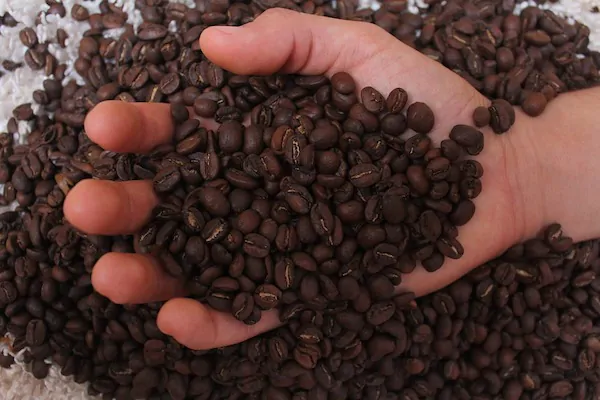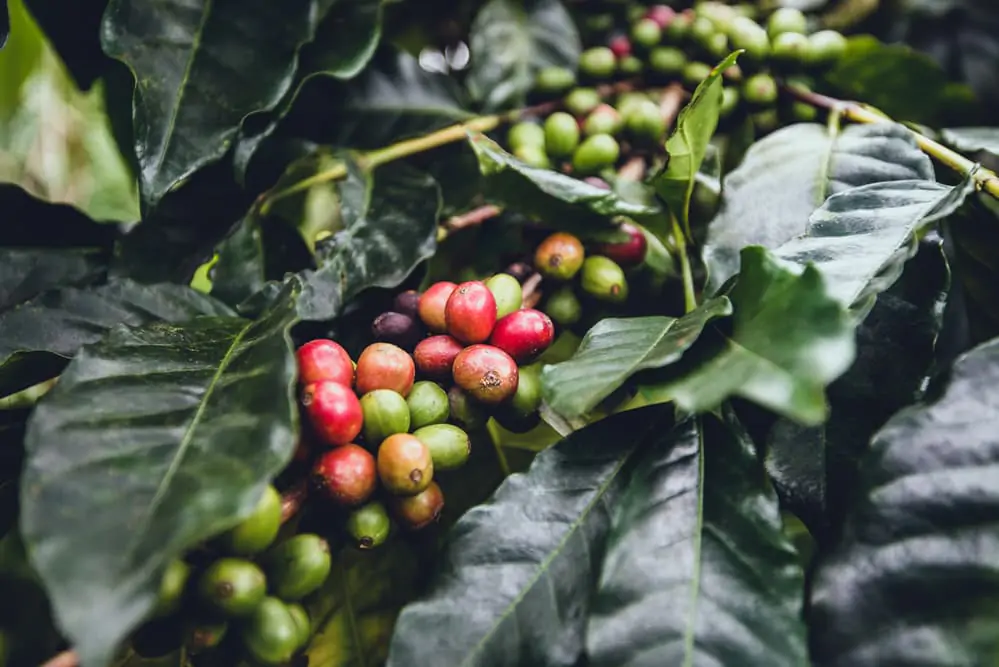Figuring out how much do coffee beans weigh will help you buy better beans for your machine.

Coffee beans: those little magical beans that create a wonderful, almost magical beverage in so many forms. Many people don’t realize how important weight is to beans, other than the selling price. But there’s much more to it than that.
Beans of equal size can weigh vastly different amounts, and that changes the flavors significantly. But coffee beans are typically sold in bags that go by the pound, so just how much bean to pound ratio is there? And what’s that got to do with flavor and quality?
How much do coffee beans weigh?
The weight of each individual coffee bean can be influenced by bean variety and size, as well as age. But most of all the weight of coffee beans is affected by roast intensity. The average weight of a coffee bean can be anywhere from .170g for an un-roasted bean, to .12g for a dark roast bean.
The main question may now be answered, but there is still much more to learn. Weight is only part of the equation of flavor. To get the most out of your coffee, the question requires a more in-depth answer. The good news is that I have that answer as well. You might also be wondering, how many coffee scoops per cup?
What Is The Average Weight Of A Coffee Bean?
Believe it or not, this isn’t a question born of pure curiosity. Knowing the weight of a specific coffee bean in your favorite roast and brand can actually help you make the perfect ratio of bean to water, choose the right grind, and even pick the right storage process. Coffee newbies often don’t realize the importance of coffee bean weight, but that’s why I’m here.
As I stated earlier, the average weight of a coffee bean can vary between .170g for an un-roasted bean like this to .12g for a well-roasted, dark bean. While these look like small numbers, you have to keep in mind that we use a whole lot of beans per cup of coffee, so those little numbers add up.
- Recommended roast profile is medium (also known as city or regular).
- From our most recent harvest, premium Arabica unroasted green beans from the best Caturra micro-lots at our fourth generation family farm.
- Specialty green coffee beans with 5 or less defects and no primary defects per 300 grams; moisture content between 11-12%.
- Strictly high grown under shade trees, harvested by hand, European prepared, fully washed and naturally dried.
If you’re lucky, then when you purchase your beans, you may see the per-bean weight right on the bag or container. You may even be able to talk to the bean people in charge and find out for sure.
That’s not typical, however. Divulgence of coffee bean weights doesn’t happen often. But that shouldn’t stop you from figuring it out.
So, how do you know the weight of a coffee bean? Oddly enough, that answer goes all the way back to the coffee cherry.
Coffee Bean Weight And The Coffee Cherry

Coffee comes from the coffee cherry. Many animals eat the coffee cherry and later pass the coffee seeds—what we call coffee beans—as waste. Most of the coffee sold in America, however, doesn’t need to take that unsettling trip.
Coffee cherries are harvested, and then they are processed immediately. The best cared-for trees can produce more coffee cherries with fatter bodies and heavier starting weights.
What that means for you and our other coffee fans is a higher starting weight for each bean, with more of that coffee goodness we crave, for a better price. Since it started out heavier, it will be heavier when it’s done the roasting.
Heavier beans fetch a higher price, of course, so it’s in the farmers‘ best interest to grow fat, healthy coffee cherries.
Coffee Bean Processing And Roasting Affects Weight
Fresh coffee seeds are red and round, and after preparing and drying, they’re small and green. At this stage, they weigh about .170 grams. After roasting, they tend to be much lighter, as the excess water inside is evaporating during this process.
How light the bean gets is controlled by how long the bean has been roasted. The longer and darker the roast, the lighter in weight the bean becomes.
Coffee roasting happens in giant drums that are heated to approximately 550 F. They tumble around in there to prevent the beans from getting burnt, but the motion also helps evaporate the moisture more evenly.
Simply put: light roasted beans will be heavier than dark roast because the there is more moisture and oils left in light roast.
See Also: WHY ARE SOME COFFEE BEANS OILY?
Coffee Packaging Affects Weight
Not only does the roast level matter, but you should also take into consideration the packaging that your coffee beans come in. For instance, some shadier places may say you have one pound of coffee, but they actually weighed it in a metal tin or another kind of heavy package.
That adds to the overall weight, but you end up with less coffee. You should be sure to read all over a package to see if you’re getting your money’s worth.
There are some places that will weigh your coffee right in front of you. That’s your best bet for getting what you pay for. Make sure they zero out the scale after putting your empty bag on so you’re only paying for the coffee beans themselves.
Why Would You Want To Know The Weight Of A Coffee Bean?

That seems like a lot of extra knowledge, I know. But there’s an important reason for this. Knowing the approximate weight of the coffee beans of your choice can help you to find the price and value per pound, which may, in turn, help you to identify whether a bag may be overpriced or not.
It’s also a good way to keep track of the quality of your coffee, to be sure the quality stays consistent over time with each purchase and can help you make a tastier cup of Joe each time.
How Can You Use Coffee Bean Size To Your Advantage?
Well, for one, coffee is typically sold by weight, not volume. So, theoretically, a one-pound bag of dark roast would have more coffee in it than a one-pound bag of a lighter roast.
But you’re also getting heavier, denser beans with the lighter roast, so one might argue they cancel each other out. That’s really for you to decide though—which is a better bargain for you.
This also means that when you buy a one-pound bag of whole coffee, then buy the same coffee but pre-ground, they will be different sizes. The bag of pre-ground will appear smaller than the ground bag.
You may feel like you’re getting less coffee but remember: it’s the weight that matters, not volume. That ground coffee is still just one pound because the beans have been pulverized into bean sand, and bean sand takes up very little space than a fat, full bean does. Science!
Another way to take advantage of the bean weight knowledge is storage and tracking freshness. Beans are going to lose some moisture and oils as they sit around waiting to be ground up.
You can actually see this happening by weighing your freshly-purchased beans, leaving them untouched for two weeks, then weighing them again. They should be slightly lighter than the first weigh-in. That’s evaporation.
That knowledge helps you make better choices when storing your coffee. The longer it’s stored, the more moisture and oils you’ll lose. That means less flavor for your morning cup.
Why Do Coffee Beans Have Different Weights?
The weight of every batch of coffee beans is going to be different, that’s just how organic things work. Unfortunately, while I can’t list all of the different types of coffee out there (there’s a lot!), I can give an average of what the typical coffee bean weighs at different roast levels.
While the size of a coffee bean isn’t really going to change much after being roasted at different lengths of time, they do get lighter when roasting. It’s also important to note that beans are sorted by size and weight before roasting, too.
This is why we can get expensive gourmet coffee at a favorite boutique or the cheap, stale stuff at the budget grocery store down the road.
Fun fact: For every pound of coffee, there are approximately 4,000 beans. Now that’s a lot of beans!
The Final Word: How Much Do Coffee Beans Weigh?
Coffee beans aren’t all one uniform weight and size, which can make finding a nice consistent number a little difficult. The weight of coffee beans is affected by several factors, such as size and bean type, but is definitely more influenced by roast intensity.
However, if you wanted an average for coffee bean size, they can typically weigh anywhere between .170g for a green un-roasted bean, to .12g for a dark roast bean.
How Much Do Coffee Beans Weigh Related Questions
How are coffee beans made?
Coffee cherries are picked, stemmed, then washed before the outer pulpy part is removed. After the outer pulp is removed and they go through one more cleaning, the beans are then sent to a coffee roaster and roasted at around 400 degrees Fahrenheit, at various different times. The longer the coffee beans are cooking, the darker the end roast will be.
Are un-roasted and green coffee beans the same?
While green coffee beans and un-roasted coffee beans are both different names, they do mean the same thing and can be used interchangeably if you so desire. Both mean a coffee bean that hasn’t yet been roasted.

